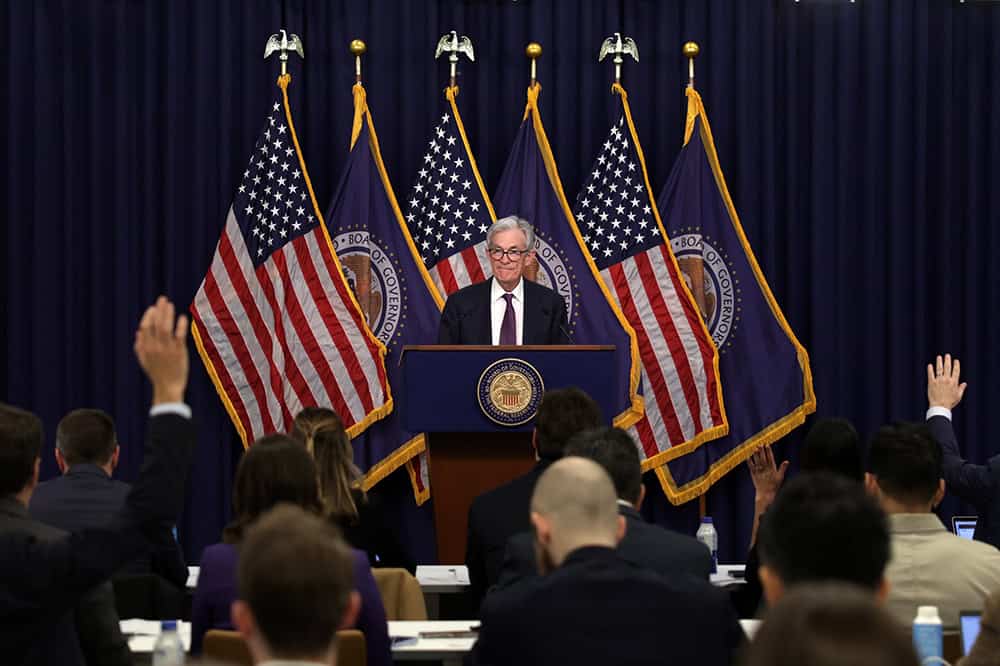As Voters Head to Polls, US Fiscal Confidence Is Significantly Lower than Prior Elections
The October 2022 Fiscal Confidence Index, Modeled after the Consumer Confidence Index, is 40 (100 is Neutral)
NEW YORK (October 27, 2022) — As Americans head to the polls for early and Election Day voting, they have significantly less confidence in our nation’s fiscal outlook than in previous election years. Coming on the heels of the national debt eclipsing $31 trillion for the first time earlier this month, the Peter G. Peterson Foundation’s Fiscal Confidence Index for October is 40 (100 is neutral) — 14 points below October 2020 and 22 points below October 2018.
Rising voter concern about the debt and leaders’ failure to manage it contributed to this month’s decline, with 80% of voters saying their concern has increased and 68% believing the country is on the wrong track when it comes to addressing the debt. Nearly three-in-four voters (72%) feel the national debt should be a top-three priority for Congress and the president, including 63% of Democrats, 70% of independents, and 85% of Republicans.
“With high inflation, economic uncertainty and the national debt surpassing $31 trillion, voters are rightly concerned about our nation’s fiscal and economic outlook in this year’s pivotal election,” said Michael A. Peterson, CEO of the Peterson Foundation. “Interest costs are consuming more of the federal budget than ever, on pace to triple from $1 billion per day now to $3 billion per day within 10 years. Americans across party lines are looking for leaders to act on overdue solutions to stabilize our budget, support a strong economy and build broad-based opportunity.”
The Fiscal Confidence Index measures public opinion about the national debt by asking six questions in three key areas:
- CONCERN: Level of concern and views about the direction of the national debt.
- PRIORITY: How high a priority addressing the debt should be for elected leaders.
- EXPECTATIONS: Expectations about whether the debt situation will get better or worse in the next few years.
The survey results from these three areas are weighted equally and averaged to produce the Fiscal Confidence Index value. The Fiscal Confidence Index, like the Consumer Confidence Index, is indexed on a scale of 0 to 200, with a neutral midpoint of 100. A reading above 100 indicates positive sentiment. A reading below 100 indicates negative sentiment.
Fiscal Confidence Index Key Data Points:
- The October 2022 Fiscal Confidence Index value is 40. (The September value was 46. The August value was 44.)
- The current Fiscal Confidence Index score for CONCERN about the debt is 32, indicating deep concern about the debt. The score for debt as a PRIORITY that leaders must address is 30, indicating that Americans want elected leaders to make addressing long-term debt a high priority. The score for EXPECTATIONS about progress on the debt is 59. The Fiscal Confidence Index is the average of these three sub-category scores.
- For a description of the complete methodology, see the Appendix below.
The Peter G. Peterson Foundation commissioned this poll by the Global Strategy Group and North Star Opinion Research to survey public opinion on the national debt. The online poll included 1,000 registered voters nationwide, surveyed between October 17, 2022 and October 19, 2022. The poll has a margin of error of +/- 3.1%. The poll examined voters’ opinions on the national debt, political leadership, and America’s fiscal and economic health.
Detailed poll results can be found online at: www.pgpf.org/FiscalConfidenceIndex.
About the Peter G. Peterson Foundation
The Peter G. Peterson Foundation is a nonprofit, nonpartisan organization that is dedicated to increasing public awareness of the nature and urgency of key fiscal challenges threatening America’s future, and to accelerating action on them. To address these challenges successfully, we work to bring Americans together to find and implement sensible, long-term solutions that transcend age, party lines and ideological divides in order to achieve real results. To learn more, please visit www.pgpf.org.
APPENDIX: Fiscal Confidence Index Methodology and Questions
- The Fiscal Confidence Index is released monthly by the Peter G. Peterson Foundation.
- The Fiscal Confidence Index value is based on six questions in three categories.
- As is done with the Consumer Confidence Index, the first step in calculating the Fiscal Confidence Index is determining the “Relative Value” for each question. This calculation is made by taking the positive response for each question and dividing it by the sum of the positive and negative responses. Each question was asked on a four-point scale, and answers were weighted according to intensity, with the strongest responses counting twice as much as the middle responses (“much” better or worse answers count twice as heavily as “somewhat” better or worse answers).
- The scores for the Concern, Priority, and Expectations categories are determined by averaging the scores derived from the two questions in each category.
- The Fiscal Confidence Index value is converted from the Relative Value to place it on a scale on which 100 indicates equal positive and negative sentiment, while values below 100 indicate negative sentiment and values above 100 indicate positive sentiment.
- The questions are as follows:
| CONCERN (32) | |||
|---|---|---|---|
| Thinking about our national debt over the last few years, would you say your level of concern has increased or decreased? ◊ Is that a lot or just a little? |
Oct 2022 | Sept 2022 | Aug 2022 |
| Increased a lot | 51% | 52% | 52% |
| Increased a little | 29% | 29% | 28% |
| Decreased a little | 4% | 6% | 6% |
| Decreased a lot | 2% | 3% | 2% |
| (No change) | 10% | 8% | 10% |
| (Don’t Know/Refused) | 3% | 2% | 3% |
| INCREASED (NET) | 80% | 81% | 80% |
| DECREASED (NET) | 7% | 9% | 8% |
| When it comes to addressing our national debt, would you say things in the United States are heading in the right direction or do you think things are off on the wrong track? ◊ Do you feel that way strongly or just somewhat? |
Oct 2022 | Sept 2022 | Aug 2022 |
| Right direction — Strongly | 9% | 13% | 11% |
| Right direction — Somewhat | 19% | 20% | 22% |
| Wrong track — Somewhat | 25% | 22% | 24% |
| Wrong track — Strongly | 43% | 42% | 40% |
| (Neither/Mixed) | 1% | 1% | * |
| (Don’t Know/Refused) | 3% | 2% | 2% |
| RIGHT DIRECTION (NET) | 28% | 33% | 33% |
| WRONG TRACK (NET) | 68% | 64% | 65% |
| PRIORITY (30) | |||
|---|---|---|---|
| Some people say that addressing the national debt should be among the president and Congress’ top 3 priorities. Do you agree or disagree? ◊ Do you feel that way strongly or just somewhat? |
Oct 2022 | Sept 2022 | Aug 2022 |
| Strongly agree | 48% | 51% | 48% |
| Somewhat agree | 24% | 24% | 26% |
| Somewhat disagree | 17% | 16% | 16% |
| Strongly disagree | 6% | 5% | 5% |
| (Don’t Know/Refused) | 5% | 5% | 4% |
| AGREE (NET) | 72% | 74% | 75% |
| DISAGREE (NET) | 23% | 21% | 21% |
| And when it comes to our national debt, do you think it is an issue that the president and Congress should spend more time addressing or less time addressing? ◊ Would you say a lot (more or less) time or just a little? |
Oct 2022 | Sept 2022 | Aug 2022 |
| A lot more time | 49% | 52% | 47% |
| A little more time | 30% | 31% | 34% |
| A little less time | 8% | 6% | 8% |
| A lot less time | 3% | 4% | 3% |
| (The same amount of time) | 4% | 5% | 4% |
| (Don’t Know/Refused) | 5% | 3% | 4% |
| MORE TIME (NET) | 79% | 83% | 81% |
| LESS TIME (NET) | 11% | 10% | 11% |
| EXPECTATIONS (59) | |||
|---|---|---|---|
| And thinking about our national debt over the next few years, do you expect the problem to get better or worse? ◊ Is that much (better or worse) or just somewhat (better or worse)? |
Oct 2022 | Sept 2022 | Aug 2022 |
| Much better | 7% | 9% | 7% |
| Somewhat better | 16% | 22% | 23% |
| Somewhat worse | 32% | 28% | 29% |
| Much worse | 38% | 35% | 34% |
| (No change) | 3% | 2% | 3% |
| (Don’t know/Refused) | 5% | 3% | 4% |
| BETTER (NET) | 23% | 31% | 30% |
| WORSE (NET) | 69% | 64% | 63% |
| And when it comes to our national debt, are you optimistic or pessimistic that the United States will be able to make progress on our national debt over the next few years? ◊ Would you say you are very (optimistic or pessimistic) or just somewhat? |
Oct 2022 | Sept 2022 | Aug 2022 |
| Very optimistic | 7% | 10% | 8% |
| Somewhat optimistic | 31% | 36% | 34% |
| Somewhat pessimistic | 35% | 29% | 33% |
| Very pessimistic | 21% | 20% | 19% |
| (Neither/Mixed) | 2% | 2% | 2% |
| (Don’t Know/Refused) | 3% | 3% | 3% |
| OPTIMISTIC (NET) | 38% | 46% | 42% |
| PESSIMISTIC (NET) | 56% | 49% | 53% |
Further Reading
Should We Eliminate the Social Security Tax Cap?
There have been a number of proposals to increase, eliminate, or otherwise adjust the payroll tax cap as a way to shore up Social Security’s finances.
The Fed Reduced the Short-Term Rate Again, but Interest Costs Remain High
High interest rates on U.S. Treasury securities increase the federal government’s borrowing costs.
No Taxes on Tips Will Drive Deficits Higher
Here’s how this new, temporary deduction will affect federal revenues, budget deficits, and tax equity.


